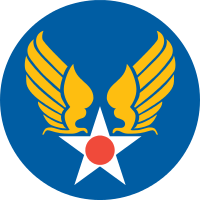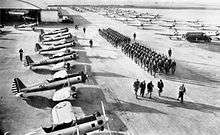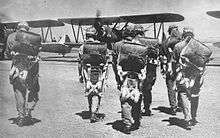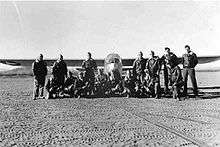United States Army Air Forces Contract Flying School Airfields
USAAF Contract Flying Schools | |
|---|---|
| Part of Army Air Forces Flying Training Command | |
|
A flying cadet and his instructor stand next to a PT-17 Stearman at Souther Field, Americus, Georgia. | |
| Site information | |
| Controlled by | United States Army Air Forces |
| Site history | |
| In use | 1939-1945 |
| Garrison information | |
| Garrison | Army Air Force Training Command |
During World War II civilian flying schools, under government contract, provided a considerable part of the flying training effort undertaken by the United States Army Air Forces.[1]
History
With the consolidation of pilot training by the United States Army Air Corps in 1931, nearly all flying training had taken place at Randolph Field, near San Antonio, Texas. During the 1930s, Randolph had produced about 500 new pilots per year, which was adequate for the peacetime air corps.[2] With war clouds gathering in Europe, especially after the 1938 Munich Agreement, General Henry H. Arnold, the Chief of Staff of the Air Corps, realized that the Army was going to have to increase the number of its pilots in case of a general war breaking out again. As a result, Arnold and his command staff developed a plan to supplement the training at Randolph with military pilot training conducted by the civil flight schools in the United States.[2]
Prewar years
In late 1938, eleven flight schools were contacted by the United States Army Air Corps by Arnold without any funding or Congressional Authorization. Arnold asked if they would, at their own expense, set up facilities to house, feed and train Army pilots. He promised that the Army would pay the schools $1,170 for each pilot that completed a primary flight training course, and $18 per flight hour for each student that washed out. Arnold received a commitment from eight flying schools, accepting his proposal.[2]

In April 1939, Congress authorized $300 million for the Air Corps to procure and maintain 6,000 aircraft. In the authorization, the Air Corps was authorized to enroll Army Flight Cadets in civilian training schools. Moving forward, in June 1939, the War Department approved Arnold's request to organize nine civilian flight schools to train Army pilots.[2] Flight training would begin at most of these schools in July 1939. After the spring offensive by Nazi Germany and the Fall of France in May, 1940, the Army, Arnold increased the rate of pilot training from 4,500 to 7,000 pilots per year. Each of the nine Contract Pilot Schools (CPS) were requested to open an additional school to accommodate this increase. In August 1940, the rate of pilot training was ordered increased to 12,000 per year.[2]
All civil flying instructors had to be certified by the CAA, as well as the ground school instructors and aircraft mechanics. Also flying instructors had to undergo a two-week Army refresher program. In order to exempt the instructors and mechanics from the wartime draft, all were enlisted into the Army as privates in the Army Reserve. Each CPS was commanded by an Army officer (mostly, but not all West Point graduates), who supervised all aspects of the program as well as insuring that military discipline was maintained. Also, a few Air Corps pilots conducted all check rides.[2]

However, the existing CPS contractors were unable to expand to train this increased number. In response, the Air Corps issued a request for bid (RFB) to all of the 38 Civil Aeronautics Administration (CAA) approved flying schools in the country outlining the specifications for Army pilot training. From the schools responding to the RFB, the Air Corps selected eleven new contractors for Army primary flight training.[2] With the war in Europe expanding, and the threat of war with the Japanese Empire becoming more and more a possibility, the Chief of Staff of the Army directed Arnold to increase pilot training to 30,000 per year. To meet this new rate, the CPS concept was again expanded by converting three of the Level 1 primary CPS schools to Level 2 basic flying training and expanded the number of CPS contractors.[2]
However, in the strictest sense, these schools were not owned or leased by the USAAF, and for the most part, they were not designated or activated as Army Air Fields. In official Army directories, they were listed by the name of the civilian flying school, the name of the airport on which it operated, or sometimes just by the city name.[1]
In addition to the Air Corps demands for civil flying schools to train military pilots, in late 1940, President Franklin Roosevelt accepted a proposal from British Prime Minister Winston Churchill that the United States train Royal Air Force (RAF) pilots at civilian flying schools. The first RAF flight cadets began training in the United States in June 1941. The Army Air Corps (later Army Air Forces) maintained a small liaison detachment at each of these schools, however the RAF provided a cadre of officers for military supervision and training, while flight training was conducted by contract flying schools.[1]
World War II
Primary Flight Training
After the Japanese attack on Pearl Harbor and both Fascist Italy and Nazi Germany's declaration of war against the United States in December 1941, plans were made by the Army to increase the training rate to 50,000, then 70,000 and finally 102,000 pilots per year. The Defense Plant Corporation (DFC) purchased all of the CFS's and leased the facilities back to the civilian contractors.[2] This effectively made them government property, although they continued to be operated by the civilian contractors. The DFC then funded the construction of all future CPSs.[1]



The CFS's were assigned to the various Flying Training Commands, and each had a designated USAAF Flying Training Detachment assigned for supervision and liaison with the command. According to the contract, the government supplied students with training aircraft, flying clothes, textbooks, and equipment. Schools furnished instructors, training sites and facilities, aircraft maintenance, quarters, and mess halls.[1] To the flying cadets, the CPSs were just another training assignment—although the flight instructors were civilian contractors, the cadets still experienced the discipline and drudgery of military life.[1]
Due to the wartime pressure to produce pilots rapidly the AAF paid scant attention to their military training. The atmosphere of the civilian-operated primary schools was not conducive to the development of rigid discipline, and too little time was available for military instruction at all the stages of pilot training. What instruction there was, over and above the regimen of Army life, was restricted largely to marching, ceremonies, inspections, and military customs and courtesies. The vigorous physical conditioning, however, continued and intensified during flying training.[3]
Trainers used were primarily Fairchild PT-19s, PT-17 Stearmans and Ryan PT-22s, although a wide variety of other types could be found at the airfields. The primary training syllabus was initially twelve weeks in length including 60 hours of flight time and 225 hours of ground training. However this was changed by the Army as the situation required. Although the number of flight hours remained at 60 throughout the war, the demands of the increasing pilot training rate resulted in the primary training to be reduced to ten weeks in 1940, then reduced to nine weeks in 1942. [1]
The instruction given at the CPSs was an adaptation of the primary phase formerly taught at Randolph Field. Each student in primary was required to make at least 175 landings. As given at the height of the effort, primary flying training was divided into four standard phases. In the pre-solo phase students became familiar with the general operation of a light aircraft. In the second, or intermediate phase, pre-solo work was reviewed, and precision of control was developed. The third, or accuracy, phase demanded high proficiency in various types of landing approaches and landings, and the fourth, or acrobatic, phase required ability to perform loops, Immelmann turns, slow rolls, half-rolls, and snap rolls. In 1944, after the training demand had peaked, the course length was increased back to ten weeks.[3]
The Army Air Forces never reached the 102,000 pilot training rate. This was reduced to a more realistic rate of 93,600 in June 1943. The peak of AAF flying training was reached in November 1943 when the CPSs graduated 11,411 cadets. After that AAF flight training began a gradual reduction that resulted in the closing of most of the CPSs in the fall of 1944. Ten CPSs remained in operation in 1945, which were closed at the end of World War II and the Army Air Forces returned to in-house primary pilot training.[2]
Glider Pilot Training
A subset of the CFS's were Glider Training Schools. Their mission was to train unpowered glider pilots; not powered aircraft pilots. Military Gliders were a new development that began in the 1920s when after the Treaty of Versailes, the German Air Force was disbanded. However, the treaty did not prohibit Germany from having sport gliding clubs, and by the late 1920s, many glider flying clubs had been established throughout the country. When the Nazi Party took over Germany in the early 1930s, the young men in the glider clubs formed the core of the new Luftwaffe.[4] German DFS-230 combat gliders were used in the invasion of Belgium in May 1940 when they landed on top of the Eben Emael Fort and captured it. They were also used in the invasion of Crete. These actions led to the British and later American interest in Combat Gliders and their integration into their armed forces.[4]


In 1941 the Air Corps directed Flying Training Command to establish a glider training program, however given the Army's inexperience, it was decided to utilize civilian glider and soaring schools in a similar manner to the primary powered flight program.[1] Many glider pilots were already qualified and skilled powered aircraft pilots who had earned their CAA (Civil Aeronautic Administration) civilian pilot's license before war broke out. Other trainees for the glider pilot program had already gone through flight training but had been disqualified, not for lack of skill, but for problems beyond their control such as slightly deficient eyesight.[1]
The main operation got under way at Twenty Nine Palms Army Airfield, in the California desert, where thermal conditions were great for soaring flights. A facility, named Condor Field, was utilized with C-47 Skytrains flown by Women Airforce Service Pilots (WASP)s being used as tow tugs for the gliders, with Laister-Kauffman TG-4A sailplanes used for glider training.[1]
However, it was learned that the military gliders under development were fundamentally different in their flight characteristics than sailplanes in their handling, and especially the fact that once released, a military glider did not soar as a sailplane does. The combat gliders under development could not soar and gain altitude once the pilot released the tow line as a sailplane could. They could only descend, and once a pilot committed to a landing and discovered, as he got closer, that the landing zone was under fire, mined, or otherwise obstructed, he had little room to maneuver to make a safe landing.[1]
As a result, the TG-4A sailplanes were replaced by Aeronca TG-5As, Taylorcraft TG-6As, and Piper TG-8As unpowered glider conversions of powered light observation aircraft which had similar characteristics to the military gliders under development.[5] As part of the training program, cadets learned to perform maintenance and, in an emergency, to rebuild wrecked gliders. This was a relatively simple operation, considering that the primary glider consisted of little more than a shell, equipped with radio, wheels, and brakes.[1]
The schools at Twentynine Palms, CA, Mobile, AL, Wickenburg, AZ, and Lamesa, AZ, were the first Glider Training Schools to open.[6] Once the Glider Pilot Cadet successfully completed their primary training, they moved on to advanced training, taught by AAF instructors at several military glider schools using the CG-4A Waco and British Airspeed Horsas that the pilots would eventually fly into combat during several operations primarily in the European Theater.[1]
Once in operational Troop Carrier squadrons, the gliders and their pilots were initially established as separate flights in the squadron organization. However, in late 1943, it was decided that having a separate glider force within the Troop Carrier squadrons, it was decided to end the separate glider instruction program and integrate the glider flying and maintenance training program into the Troop Carrier training program. The contract Glider Schools were subsequently closed or converted into Primary Flight Schools and all glider training was conducted by military glider pilot instructors at schools at Army Air Bases.[1] [6]
Closure
During the course of the war, the schools graduated approximately 250,000 student pilots. All of the CFS's were inactivated by the end of the war, and were either turned over to the War Assets Administration (WAA) for disposal, or sold back to their previous private owners. Most today are small general aviation airports; some are major municipal airports, and some were abandoned with little or no evidence of their existence.[1]
List of Contract Flying Schools
Eastern Flying Training Command
|
|
- Glider Training Schools
|
|
Central Flying Training Command
|
|
- Glider Training Schools
|
|
Western Flying Training Command
|
|
- Glider Training Schools
|
|
British Flight Training Schools
Royal Air Force flying cadets used the PT-17 or PT-19; the BT-13 and AT-6 for their training in the United States. Unlike the Army Air Forces, RAF cadets remained at the same airfield for all three levels of their training.[11]
The RAF requested that the level 2 Basic training be dropped from the syllabus, and cadets transition directly from the primary trainers to the advanced AT-6 trainer. This was eventually adopted by the USAAF beginning in the fall of 1944.[11]
|
|
References
- 1 2 3 4 5 6 7 8 9 10 11 12 13 14 15 Manning, Thomas A. (2005), History of Air Education and Training Command, 1942–2002. Office of History and Research, Headquarters, AETC, Randolph AFB, Texas ASIN: B000NYX3PC
- 1 2 3 4 5 6 7 8 9 10 Willard Weiner (1945), Two Hundred Thousand Flyers,: the Story of the Civilian AAF Pilot Training Program. Publisher: The Infantry Journal
- 1 2 Craven & Cate, The Army Air Forces in World War II. Volume VI Men and Planes, Chapter 17, Individual Training of Flying Personnel
 This article incorporates text from this source, which is in the public domain.
This article incorporates text from this source, which is in the public domain. - 1 2 Lowden, John L, A Brief History of the Combat Glider in World War II
- ↑ COMBAT GLIDER PILOT TRAINING
- 1 2 3 4 5 6 7 8 9 10 11 12 13 14 15 16 17 18 19 20 21 22 23 24 25 26 27 28 29 WW2 US Army Air Force CG-4A Combat Glider History Report
- 1 2 3 4 5 6 7 8 9 10 11 12 13 14 15 16 17 18 19 20 21 22 29th Flying Training Wing, lineage and history document Air Force Historical Agency, Maxwell AFB, Alabama
- 1 2 3 4 5 6 7 8 9 10 11 12 13 14 15 16 17 18 19 20 21 22 23 24 25 26 27 28 29 30 31 32 33 34 35 36 37 38 39 40 41 42 43 44 45 46 47 48 49 50 51 52 53 54 55 56 57 58 59 60 61 62 63 64 65 66 67 68 69 70 71 72 73 74 75 76 77 78 79 80 81 82 83 84 85 86 87 88 89 90 91 92 93 W.W.II Army Air Forces Contract Flying School Airfields - Database Summary
- 1 2 3 4 5 6 7 8 9 10 11 12 13 14 15 16 17 18 19 20 21 22 31st Flying Training Wing, lineage and history document Air Force Historical Agency, Maxwell AFB, Alabama
- 1 2 3 4 5 6 7 8 9 10 11 12 13 14 15 16 17 36th Flying Training Wing, lineage and history document Air Force Historical Agency, Maxwell AFB, Alabama
- 1 2 3 4 5 6 7 8 9 British Flight Training Schools (BFTS)
